ADVENTURE VI. - THE ADVENTURE OF SILVER BLAZE
BY A. CONAN DOYLE
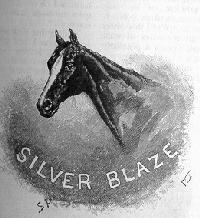
Is it an accident that the white on Silver Blaze's head resembles
the white streak that sets off a pair of spats and an imaginative mind?
ADVENTURE VI. - THE ADVENTURE OF SILVER BLAZE
BY A. CONAN DOYLE

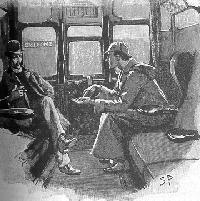 Obviously,
Holmes has imagination. Who else would wear a deerstalker hat, and
an oversized hooded duster to the moors of Dartmoor then put on a pair
of spats to finish the wardrobe? In this interior scene of the railroad
carriage, his traveling companion, Dr. Watson is much more conservatively,
and unimaginatively dressed. With his formal, coat and collar, bowler and
boots he is suitably attired to both meet the sportsman, Colonel Ross
and tramp the moors in search of a lost horse. Juxtaposed by
Paget across from Holmes in a first class railroad car, Watson is
the stereotypical practical Victorian traveler legs crossed and cigar dangling,
while Holmes, looks as if he is trying out a new disguise that incorporates
a wild mismatch of GQ, Lands End and Trappist monk attire.
Obviously,
Holmes has imagination. Who else would wear a deerstalker hat, and
an oversized hooded duster to the moors of Dartmoor then put on a pair
of spats to finish the wardrobe? In this interior scene of the railroad
carriage, his traveling companion, Dr. Watson is much more conservatively,
and unimaginatively dressed. With his formal, coat and collar, bowler and
boots he is suitably attired to both meet the sportsman, Colonel Ross
and tramp the moors in search of a lost horse. Juxtaposed by
Paget across from Holmes in a first class railroad car, Watson is
the stereotypical practical Victorian traveler legs crossed and cigar dangling,
while Holmes, looks as if he is trying out a new disguise that incorporates
a wild mismatch of GQ, Lands End and Trappist monk attire.
But, Watson's very practical attire matches his very
practical observations that Straker's wounds may be self-inflicted
and the observation that Silver Blaze was joined by a human on the moor.
"Quite so," says Holmes and thanks Watson for saving them a long trip.
But this is condensation of the worst kind. Watson is two steps behind
Holmes, and the attire Paget dresses him in confirms the lack of imagination
of the faithful but unimaginative friend. Paget knew that Watson would
never sport spats on the moors, but spats and a deerstalker and an outrageous
cloak would lift Holmes above the Victorian fashions of the unimaginative.
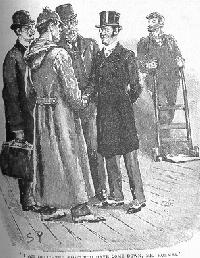 |
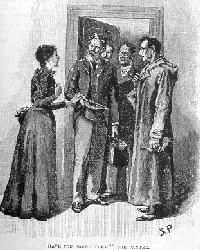 |
At first glance, Col. Ross seems unimaginative.
Doyle puts words of complaint and distrust in his mouth, but at the same
time, he trusts Holmes up to race time that Silver Blaze will run.
And at the moment of triumph, he wishes only to know the identity of the
murderer of Starker. How does Paget show this imagination?
Its the spats! He and Holmes stand clasping hands with spread spatted feet
in a recognition of the imagination of two men who see beyond the
winning of the race to greater issues. The practical booted
Gregory and Watson stand behind the two and are given a patronizing once
over by a porter in the background.
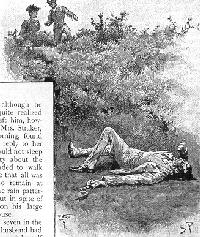 |
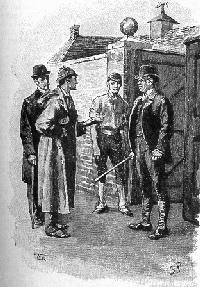 |
Paget draws Straker and Silas Brown as the
yin and yang of horse trainers. Straker's death scene depicts a typical
English workman's clothing. A common coat with no tie and boots that
do not shine. Dead in the brambles, a victim of his unimaginative idea
to geld a horse's tendon - and bested by a beast who would have nonesuch.
On the other hand, Silas Brown shrugs off the idea to do the right thing and lead Silver Blaze back to his owner and hides him in the manner of a Poe Purloined Letter, among the beasts in his own stall. A disguise good enough to fool booted inspectors, but not a bespatted detective.
Straker dies for his duplicity, while Brown lives on protected by Holmes himself, who tells Col. Ross that the horse was cared for "by one of his neighbors." A bit of fiction that is too easily swallowed by the supposedly imaginative Col Ross and can only be explained by the fact that Ross has changed from his spats to more formal footwear for the running of the Wessex Cup.
The game is afoot in this tale, and who is shod how is a key that Paget uses to reveal imagination to us all.